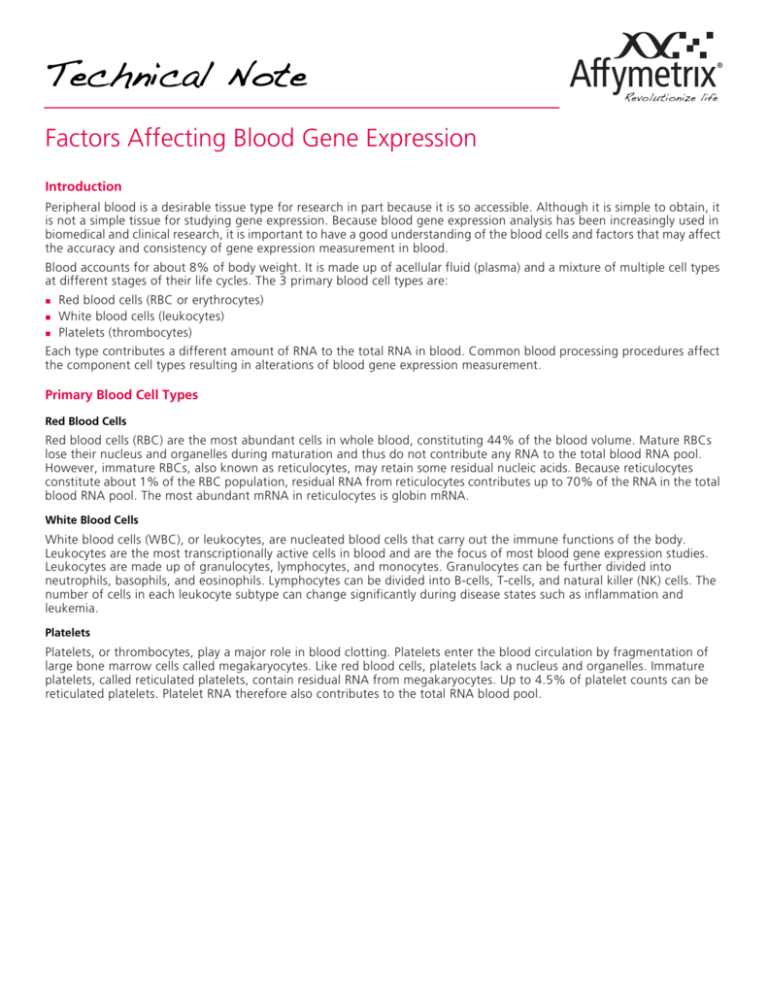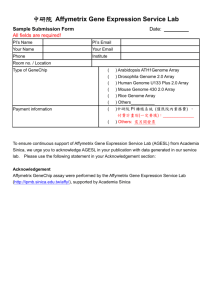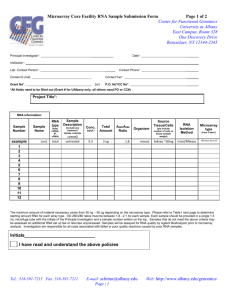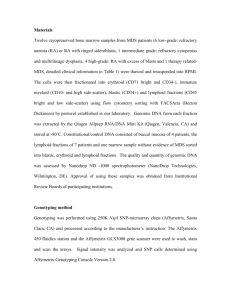
Technical Note
Factors Affecting Blood Gene Expression
Introduction
Peripheral blood is a desirable tissue type for research in part because it is so accessible. Although it is simple to obtain, it
is not a simple tissue for studying gene expression. Because blood gene expression analysis has been increasingly used in
biomedical and clinical research, it is important to have a good understanding of the blood cells and factors that may affect
the accuracy and consistency of gene expression measurement in blood.
Blood accounts for about 8% of body weight. It is made up of acellular fluid (plasma) and a mixture of multiple cell types
at different stages of their life cycles. The 3 primary blood cell types are:
Red blood cells (RBC or erythrocytes)
White blood cells (leukocytes)
Platelets (thrombocytes)
Each type contributes a different amount of RNA to the total RNA in blood. Common blood processing procedures affect
the component cell types resulting in alterations of blood gene expression measurement.
Primary Blood Cell Types
Red Blood Cells
Red blood cells (RBC) are the most abundant cells in whole blood, constituting 44% of the blood volume. Mature RBCs
lose their nucleus and organelles during maturation and thus do not contribute any RNA to the total blood RNA pool.
However, immature RBCs, also known as reticulocytes, may retain some residual nucleic acids. Because reticulocytes
constitute about 1% of the RBC population, residual RNA from reticulocytes contributes up to 70% of the RNA in the total
blood RNA pool. The most abundant mRNA in reticulocytes is globin mRNA.
White Blood Cells
White blood cells (WBC), or leukocytes, are nucleated blood cells that carry out the immune functions of the body.
Leukocytes are the most transcriptionally active cells in blood and are the focus of most blood gene expression studies.
Leukocytes are made up of granulocytes, lymphocytes, and monocytes. Granulocytes can be further divided into
neutrophils, basophils, and eosinophils. Lymphocytes can be divided into B-cells, T-cells, and natural killer (NK) cells. The
number of cells in each leukocyte subtype can change significantly during disease states such as inflammation and
leukemia.
Platelets
Platelets, or thrombocytes, play a major role in blood clotting. Platelets enter the blood circulation by fragmentation of
large bone marrow cells called megakaryocytes. Like red blood cells, platelets lack a nucleus and organelles. Immature
platelets, called reticulated platelets, contain residual RNA from megakaryocytes. Up to 4.5% of platelet counts can be
reticulated platelets. Platelet RNA therefore also contributes to the total RNA blood pool.
2
Technical Note
Cell Types in Processed Blood
The following table lists the cellular types of human whole blood, the approximate number of each cell type, and its
presence or absence after common processing procedures.
Table 1 Human whole blood cellular types
Cell Types
Red blood
cells
(Erythrocytes)
Mature
Reticulocytes
Approximate
Number in
1 μL of
Whole Blood
Blood Processing
Anticoagulated
Whole Blood
PAXgene
Blood
RBC-lysed
blood
✓
✓
—
5 x 106
5 x 104
3 x 105
Platelets
Buffy Coat
(leukocyte
preparation)
✓
PBMC
(mononuclear
cell preparation)
—
(Reduced
number)
✓
✓
✓
✓
—
(Reduced
number)
Leukocytes
(Granulocytes)
Neutrophils
Basophils
Eosinophils
5000
35
150
(Lymphocytes)
B cells
T cells
NK cells
300
1600
300
Monocytes
250
✓
✓
✓
✓
—
✓
✓
✓
✓
✓
✓
✓
✓
✓
✓
Using QuantiGene Assays for Blood Samples
The QuantiGene 2.0 or QuantiGene Plex 2.0 Assays are tools that accurately and precisely quantitates gene expression in
whole blood, capturing the gene expression profile at the time of cell lysis (1). Manipulations prior to blood cell lysis as well
as data processing after performing the assay can affect the results. The most significant known factors to affect results
are discussed below.
Blood Sample Collection
The inter- and intra-subject variation is an important issue to consider for blood gene expression studies. Inter-subject
variations may be due to differences in demographics such as age, gender, ethnic background, health and nutritional
status, metabolism, and medical history. A study of inter-subject variations in PAXgene-stabilized whole blood using
Affymetrix gene chips found that the most variable genes among 32 healthy subjects are predominantly immunoglobulin
variable region or related genes (2).
Intra-subject variations come from biological influences within the body such as hormone variation and diurnal changes.
Intra-subject variation of ribosomal and protein synthesis genes in human blood gene expression has been reported (3). A
recent study of mouse transcriptomics suggest that about 10% of the genes in various mouse tissues have a circadian
rhythm in their mRNA expression (4).
To minimize the impact of these variations on blood gene expression analysis, you should include randomized samples in
your studies with sufficient sampling size, and standardize collection time to ensure that pre- and post-treatment
collections occurs at the same time within the day.
Ex Vivo Gene Expression and Blood RNA Stabilization
Accurate analysis of in vivo gene expression in blood cells may be complicated by changes in gene expression after
phlebotomy, caused by sample collections, handling, storage, and uncontrolled coagulation (5). Intracellular RNA might be
rapidly degraded ex vivo by specific or non-specific endogenous nucleases.
Unintentional gene expression might be induced as a sensitive response of blood cells to environmental changes such as
temperature.
Technical Note
3
The blood-stabilizing reagent PAXgene was developed to prevent RNA degradation and time-dependent ex vivo induction
of cytokines and immediate early-response genes (5). However, an overall gene expression pattern distinct from regular
blood leukocytes has been observed in PAXgene-stabilized blood (6), and it has yet to be determined whether PAXgene
reagent induces expression changes in blood samples.
The QuantiGene Sample Processing Kit for blood samples offers blood lysis reagents that rapidly lyse the blood cells and
completely inactivate ribonucleases. The quick lysis preserves the gene expression pattern. Therefore, the time between
blood collection and blood lysis should be as short as possible to minimize the ex vivo expression changes.
NOTE: The QuantiGene Sample Processing Kit for blood samples includes a procedure for blood stabilized
with PAXgene.
Blood Processing and Sample Preparation
Traditionally, blood gene expression analysis is performed on leukocytes that are fractionated from whole blood to remove
interference from red cells. Buffy coat preparations contain most of the leukocytes in blood with small amounts of
contaminating red blood cells and platelets, whereas peripheral blood mononuclear (PBMC) contain only mononucleated
cells in blood (lymphocytes and monocytes), with very few other cell types.
Therefore, gene expression pattern from fractionated blood will be different from whole blood. This is not only because of
differences in blood cell composition, but also because fractionation can reportedly alter the expression of select genes
within blood cells (7).
RNA processing steps such as reverse transcription, labeling and amplification can introduce further variability. The reverse
transcription is especially problematic as the type and sequence of primers and the choice of reverse transcriptase enzyme
and the vendor can influence the final gene expression data (8). This has been an unresolved issue for technologies such
as microarray and RT-PCR which rely on reverse transcription.
The QuantiGene 2.0 and QuantiGene Plex 2.0 Assays are the first products in the market that are capable of measuring
gene expression directly from whole blood. It involves only blood cell lysis, no blood or RNA processing. The presence of
excess red blood cell proteins and RNAs such as globin mRNA do not interfere with the RNA measurement. The QuantiGene
assays directly measure the concentration of target RNA instead of its derivatives such as cDNA or cRNA.
When comparing results from the QuantiGene 2.0 or QuantiGene Plex 2.0 Assays to those from other technologies, bear
in the mind the following potential problems with other methods and technologies:
Some might require blood purification (erythrocyte lysis, for example) steps prior to RNA extraction
Some might be subject to interference from globin mRNA
Most rely on reverse transcriptase to convert mRNA to cDNA
Data Normalization
Normalizing data between samples is recommended because it corrects for small variations in the total number of cells.
Typically, sample data are normalized to the expression of an invariant housekeeping gene.
However, blood is unique in that it is one of the most variable tissue types in the body. The relative proportions of the
different types of blood cells often vary significantly from time to time and from subject to subject, even though the total
number of blood cells may not change substantially.
Example
Suppose two otherwise similar individuals have similar total WBC but 5-fold difference in monocyte counts. (The normal
range of monocytes in WBC is 1–5%.) If a monocyte-specific target gene is assayed and compared, such as a monocytespecific chemokine induced by an immune stimulation, the induction levels may appear differing by 5-fold if normalized to
GAPDH, but will actually be the same if normalized to a monocyte-specific marker such as CD14.
Therefore, it may be necessary to normalize data to common housekeeping genes, blood cell type-specific markers, or both.
References
1.
2.
3.
Zheng Z., Luo Y., McMaster G. K. Sensitive and quantitative measurement of gene expression directly from a small
amount of whole blood. Clin Chem 52:1294–302 (2006).
Fan H., Hegde P. S. The transcriptome in blood: challenges and solutions for robust expression profiling. Curr Mol Med
5:3–10 (2005).
Whitney A. R., et al. Individuality and variation in gene expression patterns in human blood. Proceedings of the National
Academy of Sciences 100:1896–901 (2003).
4
4.
5.
6.
7.
8.
Technical Note
Rudic R. D., et al. Bioinformatic analysis of circadian gene oscillation in mouse aorta. Circulation 112:2716–24 (2005).
Rainen L., et al. Stabilization of mRNA expression in whole blood samples. Clinical Chemistry 48:1883–90 (2002).
Feezor R. J., et al. Whole blood and leukocyte RNA isolation for gene expression analyses. Physiological Genomics
19:247–54 (2004).
Tamul K. R., et al. Comparison of the effects of Ficoll-Hypaque separation and whole blood lysis on results of
immunophenotypic analysis of blood and bone marrow samples from patients with hematologic malignancies. Clinical
and Diagnostic Laboratory Immunology 2:337–42 (1995).
Stahlberg A., et al. Properties of the reverse transcription reaction in mRNA quantification. Clinical Chemistry
50:509–15 (2004).
Technical Help
For technical support, contact the appropriate resource provided below based on your geographical location. For an
updated list of FAQs and product support literature, visit our website at www.affymetrix.com/panomics.
Table 2 Technical Support Contacts
Location
Contact Information
North America
1.877.726.6642 option 1, then option 3; pqbhelp@affymetrix.com
Europe
+44 1628-552550; techsupport_europe@affymetrix.com
Asia
+81 3 6430 430; techsupport_asia@affymetrix.com
US Headquarters
Affymetrix, Inc.
3420 Central Expressway
Santa Clara, CA 95051
Tel: 1-888-362-2447
Direct: 1-408-731-5000
Fax: 1-408-731-5380
Email: info@affymetrix.com
Email: orders_fremont@affymetrix.com
Email: pqbhelp@affymetrix.com
European Headquarters
Panomics Srl
Via Sardegna 1
20060 Vignate-Milano (Italy)
Tel: +39-02-95-360-250
Fax: +39-02-95-360-992
Email: info_europe@affymetrix.com
Email: order_europe@affymetrix.com
Email: techsupport_europe@affymetrix.com
Email: techsupport_asia@affymetrix.com
Asia Pacific Headquarters
Affymetrix Singapore Pte Ltd.
No.7 Gul Circle #2M-01/08
Keppel Logistics Building
Singapore 629563
Tel: +65-6395-7200
Fax: +65-6395-7300
Email: info_asia@affymetrix.com
Email: order_asia@affymetrix.com
www.affymetrix.com Please visit our website for international distributor contact information.
For research use only. Not for use in diagnostic procedures.
Rev. B 110719
© 2011 Affymetrix, Inc. All rights reserved. Affymetrix® and QuantiGene® are registered trademarks of Affymetrix, Inc. All other trademarks are the property of their respective owners.









